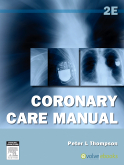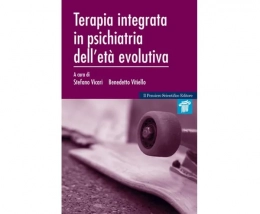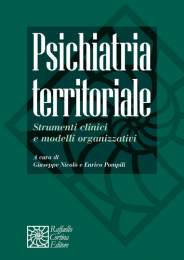Non ci sono recensioni
| Description | |
|
The Coronary Care Manual has been designed as a practical manual for the management of the acute coronary patient, and aims to achieve a balance between the large and rapidly changing evidence base and practical application in the CCU, ICU, ED and ambulance. The book has been written by a group of Australian and international experts for medical, nursing and paramedic staff working in these areas. This edition covers a broad range of coronary care medicine in enough detail to eliminate the need to refer to a larger reference book, providing a portable companion for a night "on call". Completely redesigned with new artwork, the manual is organized to suit academics and practitioners alike. |
| Author Info | |
| By Peter Thompson, MD FRACP FACC MBA, Cardiologist (formerly Director of Coronary Care at SCGH); Director of Research Development SCGH; Clinical Professor of Medicine & Population Health, UWA |
Table of Contents:
Section 1 Background to coronary care
History and future of the coronary (cardiac) care unit; Design and management of the coronary care unit; Applying evidence-based medicine in the coronary care unit; Redefinition of acute coronary syndromes and universal myocardial infarction
Section 2 Epidemiology, genetics and risk factors
Clinical epidemiology of acute myocardial infarction and coronary heart disease; Molecular genetics of atherosclerosis and acute coronary syndromes
Section 3 Pathophysiology
Coronary risk factors; Pathophysiology of atherosclerosis; Pathophysiology of coronary thrombosis; Pathophysiology of myocardial infarction; Pathophysiology of ventricular arrhythmias in myocardial infarction and sudden cardiac death; Pathophysiology of cardiac failure
Section 4 Evaluations of the patient
History; Physical examination; Electrocardiography; Biochemical markers of myocardial necrosis; Novel biomarkers in evaluation of acute coronary syndrome; Chest x-ray; Echocardiography; Exercise testing; Radionuclide imaging; Coronary computed tomographic angiography in the emergency department; Role of positron emission tomography; Cardiac magnetic resonance imaging; Coronary angiography; Electrocardiographic monitoring; Hemodynamic monitoring
Section 5 Drug therapies
Oxygen therapy; Analgesia; Antiarrhythmic drugs; Beta-blockers; ACE-inhibitors and angiotensin receptor blockers; Aldosterone blockade: role in the coronary care unit; Calcium channel blockers; Nitrate therapy in the coronary care unit; Alternative antianginal agents for acute coronary syndromes; Diuretics, digoxin, and electrolytes;Inotropic and vasoactive agents; Fibrinolytic therapy; Intravenous heparin, low-molecular-weight heparins, and thrombin antagonists; Intravenous antiplatelet agents; Oral antiplatelet therapy; Oral anticoagulants: vitamin K antagonists, factor Xa inhibitors, and thrombin-inhibitors; Lipid management after a coronary event; Stabilizing unstable plaque in acute coronary syndromes
Section 6 Non-drug therapies
Vascular access and ultrasound guidance techniques; Basic life support; Advanced life support; Positive airway pressure therapies; Circulatory assist devices including the intraaortic balloon pump; Cardiac transplantation selection criteria; Stem cells in myocardial injury; Cardioversion and defibrillation; Cardiac pacemakers and cardiac resynchronization therapy;Catheter ablation of arrhythmias; Implantable cardioverter defibrillators in patients with coronary artery disease; Pacemaker insertion and implantable cardioverter defibrillator insertion; Percutaneous coronary intervention; Coronary artery bypass surgery
Section 7 Acute coronary syndromes
Prehospital coronary care; Acute myocardial infarction: emergency department care; Acute myocardial infarction: coronary care unit admission and care; Management of ST-elevation myocardial infarction; Management of non-ST-elevation acute coronary syndromes; Acute myocardial infarction: management of cardiac arrhythmias and conduction disturbances; Acute myocardial infarction: cardiac failure and pulmonary edema; Cardiogenic shock; Acute myocardial infarction: other complications; Acute myocardial infarction: right ventricular infarction; Apical ballooning syndrome (tako-tsubo or stress-induced cardiomyopathy); Other causes of chest pain
Section 8 Other cardiac problems
Atrial fibrillation; Ventricular tachycardia; Other cardiac arrhythmias ; The cardiac surgery patient; The cardiac catheterization patient ; Care of the percutaneous coronary intervention patient; The pre- and postoperative management of the cardiac transplant recipient; Hypertensive crises; Aortic dissection; Pericardial effusion and tamponade; Pulmonary embolism in the coronary care unit
Section 9 Special problems in the coronary care unit patient
Management of diabetes in the coronary care unit; Renal dysfunction in the coronary care unit; Gastroenterology emergencies in the coronary care unit; Stroke in the coronary care unit; Bleeding complications and transfusion in acute coronary syndrome; Depression and coronary heart disease; Gender issues in the coronary care unit
Section 10 Postcoronary management
Management of the postcoronary patient; Secondary prevention of coronary heart disease; Postcoronary diet therapy; Postcoronary rehabilitation, heart failure, and exercise




